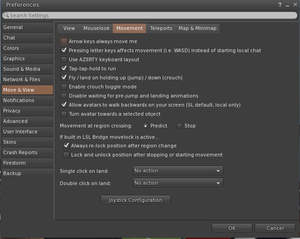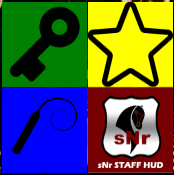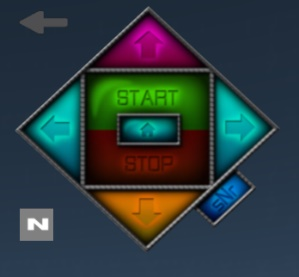Training Guides
Training Basics
Our Training Basics guide covers various topics about training and handling ponies and mares that are not specific to a discipline or skill.
Mare Handling
The sNr Ethos section gives a succint description of what we do and what we want to achieve.
However training is not enough. Livestock must be fully immersed in their mare life. Otherwise training alone will never achieve the desired traits. While it is not possible to write a detailed, thorough list of recommendations on how to act with a mare, this section will give a general idea and some principles that surely will help to act properly.
The first aspect to take care of is communication and access to information. Casual chat on IM must be avoided, using IMs only to find out how the mare is doing or when needed for training. A fully restricted mare will be frustrated and curious about the environment. With IMs open it is common to be asked questions like "who is that?". Handlers must never give a mare any information they can't gather by themselves. RLV blocks are used for a good reason and any additional information they get makes the restrictions useless.
The second key aspect for their immersion is the restriction on activities. Livestock must never take part on non pony activities at all. That includes shopping (except when necessary), dancing, parties, going to beaches, etc. Keeping livestock limited to their activities without exception will greatly improve their immersion.
Like activities, places the mare can visit will strongly reinforce the immersion feeling. Livestock should never be brought into buildings except of course barns and stables. If visiting such a place with a mare it is better to leave it hitched outside. When parking the mares at unfamiliar locations it can be a good idea to use a blindfold. Of course, as with people around, it is better to avoid explaining them anything about the places where they are brought.
Consistent handling gives excellent results in the long term and it greatly improves the effect of the training. Consider it even more critical than training itself.
Avi Steering

Some ponies try and do ponyplay without a mouse, which is really not recommended. For effective training, the pony needs to conduct all training using a mouse, in mouselook. As a special case, ponies taking part in polo competitions can be allowed to use avi steering.
To use avi-steering, grab the back of your avatar with the mouse and drag. If it doesn’t work then go to Preferences | Move & View tab | Movement Single click on land, set it to: "No action".
Etiquette Training
For new pony’s, it's recommended that staff begin training with basic behavior. It is pretty easy to do: just keep a mare leashed and have her used to follow her handler. Walk, stop, turn, stop for a long time... in all cases the mare must keep her attention focused on the handler and react immediately when the handler moves. Any slips must be immediately pointed out. And the mare must be reminded that when going afk she must signal it using the kneel gesture. This can usually be done in a one-hour session or maybe splitting it into two sessions. The key is to pay close attention to detail and point out any deficiency immediately. The mare must be aware that the trainer is really paying attention. This phase is also good to make sure that the mare can use the gestures properly. Kneeling when going afk and yawning when it must logoff. It's very important because often mares won't have IM's enabled even with the trainer. So, they need the gestures to communicate. At the point you leash a pony, it should move and stay close behind you, slightly to your right or left. The pony should greet you properly with a curtsy when you arrive, or to thank you for your training or time. The pony should be polite and respectfully, responding clearly in a timely manner, and indicate clearly when it needs to leave or is afk. As a trainer you will of course reward the pony for good behavior with an apple or a sugar cube, for instance.
Blindfolds and Patience
Although mainly used for punishment, blindfolds can be useful when parking ponies in different situations. For example, when hitching a pony in front of a store. The blindfold will keep them separated from the people around her and force her to be patient. As a training aid it's a good idea to check whether she is focused while blindfolded. Going afk must always be signaled with a kneel. A blindfolded pony who is not kneeling must still be perfectly responsive.
Carting
Carting at the sim or on LL public roads
When you feel confident, don’t just cart at sNr, take the ponies into the wild or other pony sims. If you go to FFF, you can rez one of their carts and head out onto LL Roads. Just make sure that the pony is dressed appropriately for the maturity level of the land you are going to. When starting carting for the first time, it’s best just to take one pony out. You will need the sNr Staff HUD for the cart whip commands and you can use the cart out at the back of the stables, if it is not in use. To seat the pony on the cart, it is best to use the force sit feature within Mare Control. See the section on the sNr Staff HUD on how to do this. When the pony is seated, it should default to the cart AO without the pony having to disable the AO. Now you can take a seat on the cart yourself. Press the left and right keyboard arrows at the same time to change your pose if required. Using the sNr Staff HUD, press the blue whip icon.

This will display the carting whip component of the HUD:

Whip Commands for Carting
The HUD issues whip commands for carting to the pony as follows:
- Start (1 crack) means the pony should start moving forward and follow the road ahead. Remember to click the cart to remove the handbrake first, or the cart will not move.
- Stop (2 cracks) means the pony should stop as soon as possible. This may need the pony to press Page Down a few times to go down the gears.
- Left (3 cracks) the pony should turn left at the next available opportunity.
- Right (4 cracks) the pony should turn right at the next available opportunity.
- Up will tell the pony to speed up, and they need to tap Page Up or alternatively use the "E" key. Mac users: hold down the fn key and press the up arrow.
- Down will tell the pony to slow down, and they need to tap Page Down or alternatively use the "C" key. Mac users: hold down the fn key and press the down arrow.
- Home (5 cracks) will tell the pony to reverse. They will need to press the down arrow and perhaps work down the gears to a walking pace.
- The "N" indicator in the bottom left hand corner shows the current speed you have selected for the pony and ranges from N (neutral) to gear 1 (walk), 2 (trot) and 3 (gallop).
- If the pony is in mouselook, they need to look down at the bars of the cart, to ensure they are looking straight ahead in order to be properly aligned to steer correctly.
- The arrow in the top left-hand corner takes you back to the main sNr HUD icons for when you have finished carting.
- Always give the pony time a reasonable lead time for them to react, so issue your whip command well in advance of the next course direction.
- Be aware of lag, and both you and the pony need to stay calm when this happens, and not spam commands.
- In time it will become a natural and seamless harmony between pony and trainer.
- When the cart ride has finished, reward the pony as appropriate and return them to their stall.
IMPORTANT: If you seat a pony on a cart (or anything else) using the Mare Control forcesit feature, you most also use Mare Control to unseat it at the end, or it will try and grab the pony again later. So, think before unseating the pony using the cart menu at the end of the carting session.
SIM CROSSINGS: Please try these Firestorm settings for smoother sim crossings when wild carting.
Cart racing, Speed carting
Compete, record the times, learn and improve! There are some pony sims with racing carts with tracks in order to participate.
Lap Yard
The Lapyard is to melt the ponies brain and shape it into a dumb beast of burden that performs no matter what^^
Test the animal’s commitment by patiently and diligently doing those laps! Perhaps a target number of laps has been set as a target?
- The lap circle is located in front of the stalls, below the bridge.
- If the bar across the gate is locked, press and hold your cursor against it for 3 seconds and it will be unlocked so you can open it.
- Leash the pony to the centre pole with a length of 30M and command it to start walking around the edge of the track, close to the outer walls.
- The number of laps the pony has done is indicated on the scoreboards. It will toggle between 24 hours and 1 week. The other scoreboard shows the all-time records, and they are very impressive.
- Make sure the animals are following it well and focus on their task.
Whip circle
Mares live in a really small world. With no freedom they depend on grooms and trainers in order to do anything. Moreover, their activities are very limited. For a cart mare, for example, it may mean doing only whip circle training and pulling carts. It's not an intellectually stimulating activity and it can be pretty hard to stay like a mare in the long term. It's of capital importance to train the mares for routine activities so that they get used to it as soon as possible.
- Ideally whip circle sessions should last for at least an hour. As in any other training exercise, the trainer must be aware of any faults made by the mare and point them out immediately. A training in which mistakes are unnoticed is pointless. Be aware that some mares make mistakes on purpose and discipline breaks soon with trainers who don't notice.
- Unless mistakes are too many and too frequent for the experience of the mare, it's not necessary to punish them. Warning them is more than enough. For a punishment, some time in a blindfold usually sends a strong message.
- Apart from getting used to routine, the whip circle is valuable to teach obedience. Many mares, even with good intentions, often try to outsmart their trainers by guessing the next order. Generally, it's just eagerness to "obey quickly" but that is not really obedience.
- To discourage "guessing" it's good to be irregular with whip training. Alternate periods of very fast paced commands with periods in which the mare can complete several cycles between commands. Also, tricking the mare to make a fault and, of course, pointing it when it's made, will teach it to obey instead of guessing. An example on how to trick a mare to guessing follows. A quick succession of walk-stop-walk-stop-walk-stop (repeat the walk-stop pair of signals ten times or so) followed by a stop-turn signal will often trick the mare to walk. A well trained mare will always listen for the command instead of guessing. Another technique that can be used is to change a long-term pattern. If the trainer always signals a walk after a long stop, a guessing pony will probably walk when the trainer signals a turn. Again, always point out the fault.
Whip circle is not just a simple matter of walking in circles. A well-trained mare will walk along the circle as accurately as lag allows. When stopped waiting for commands the mare must stand still. Even if the trainer takes time between commands, the mare must stand still, not looking around to try to figure what's going on. Focus is the key. Also, movements must be determined and fluid. Turns must be quick and clean with no corrections.
Practical Steps
So here are the practical steps:
- Take one or more ponies (max four) to one of the two whip circle areas.
- Have them leashed to the center pole (30 m length) and spread evenly around the track, facing the same direction. Check they are all ready before you start.
- Use your whip (and whip HUD) to issue command:
- 1 crack is start moving in the direction they are facing.
- 2 cracks are to stop.
- 3 cracks are to turn left. If they are moving, this should be done as tightly as possible, keeping to the road. If they are stopped, then they turn on the spot without moving forward.
- 4 cracks are to turn right. If they are moving, this should be done as tightly as possible, keeping to the road. If they are stopped, then they turn on the spot without moving forward.
- 5 cracks mean ‘return to whip’. The pony should approach you from the front and then curtsy before awaiting further commands, or being leashed.
- It is fun to test the pony by trying to trick them. Such as pressing stop twice in a row and seeing if they start moving, or start twice in a row and see if they stop.
- In addition, if you stop a pony then they should stay completely still and await further commands. Ponies that turn to face you to see what is happening should be corrected.
- You expect the ponies to have your full attention, so you should give them yours. Pull back your view so you can see exactly how they are responding to your commands. If you spot a fault, call it out with the pony’s name. Some trainers blindfold experienced ponies for 30 minutes if they have committed three faults.
- When finished, leash the ponies and return them to their stall.
Slalom
A true skill sport… teach the animal to get the best time they can! There are slalom training poles at sNr and other pony sims. Some slaloms are walked, some run. This will be indicated at the track. The idea is for the pony to weave around the poles to the end, do a tight turn and head back weaving as quickly as they can without hitting a pole. The pony’s time is shown on the scoreboard. As a guide, 15 seconds is acceptable, 14 seconds is good, 13 seconds amazing and 12 seconds rare. Encourage the pony and try to help them get a better time by carefully watching their movements. Be aware that lag can affect a pony’s time, so a quiet sim is sometimes preferable.
Barrels
Teach the animals to master the direction and route to get a great time. With this sport, the pony has to go around the barrels at speed in the correct order without touching them and get the quickest time they can. The correct route is usually displayed alongside the barrels. Some barrels are walked, some run. This will be indicated at the track.
Steeples
Teach the animal to be the King or Queen of those jumps! The idea of steeples is to get around the course as quickly as possible without hitting any of the fences or posts (where present). It is a true skill event and requires a lot of patience and practice to master. The pony needs to judge very carefully at which point to jump and what angle to take. In preferences | Move & View | Movement, Disable waiting for pre-jump and landing animation should not be enabled. This is enforced at formal events. In Avatar | Movement, Quickjump must not be enabled. Please don’t teach the pony bad habits, as they may not use this in formal events. It is useful for the pony to know that they can turn mid-air using avi-steering and that if they keep their jump button held down the avatar will do continuous jumps without stopping. Practice makes perfect.
Dressage
Show off the beauty and elegance of your silent bond with your animal with dressage. Knowledge of this subject is not required to pass the Trainer Exam. The main styles are Silent Dressage and Pony Flower (also known as Flower Dressage).
Polo
Represent sNr or come support your home stables! The teaching of polo is beyond the scope of this guide but there is a polo field at sNr for you to practice on or have ad-hoc matches. Any staff member can set up an impromptu game - and ponies usually find it fun. For those interested in going pro, SnR has a team in the Polo League where stables compete against each other in organised league. Send a message to the Group chat, or speak to a Senior Trainer or above for more information.